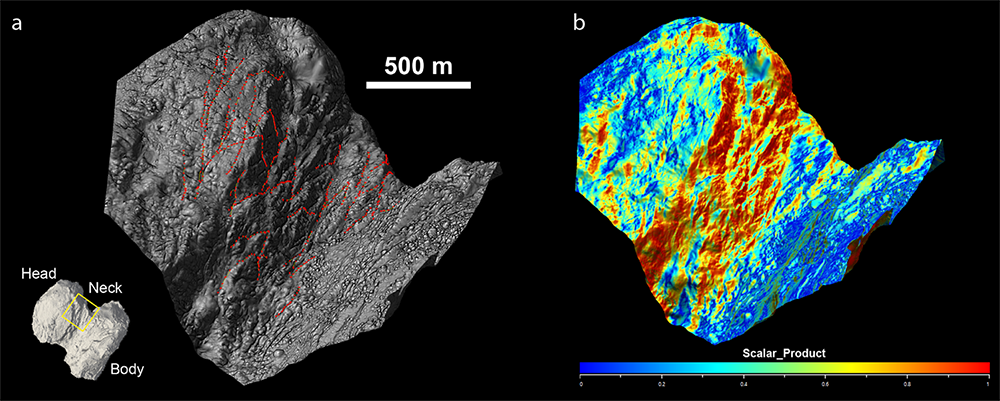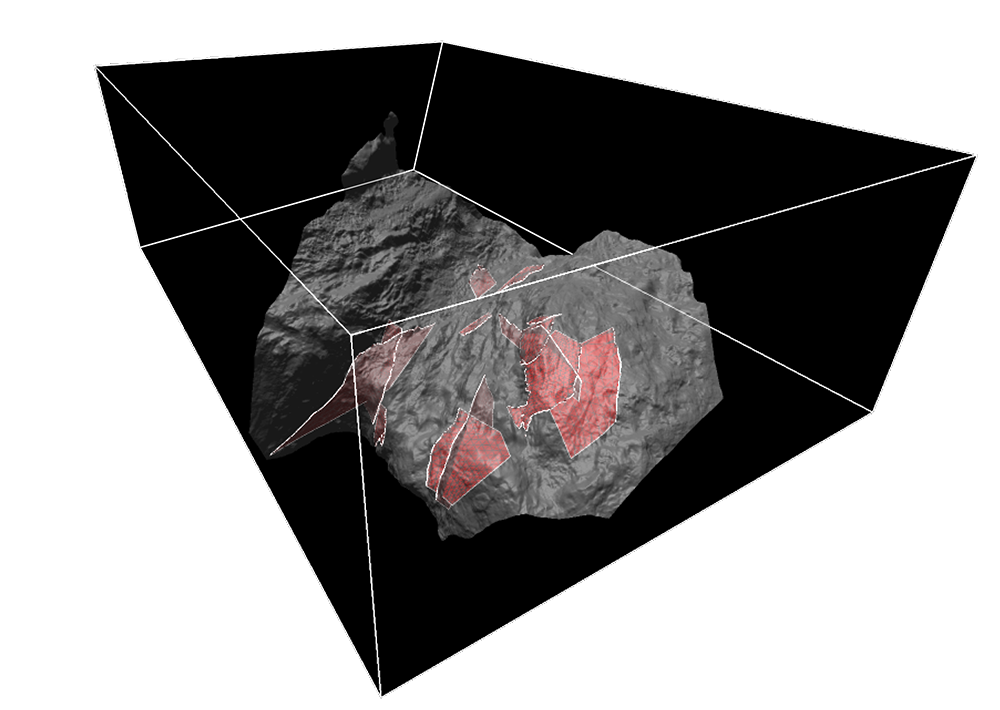3D modelling of the fault network in the interior of 67P
- 1Observatoire de la Côte d'Azur, Université Côte d'Azur, CNRS, IRD, Géoazur, Valbonne, France. (christophe.matonti@geoazur.unice.fr)
- 2Aix-Marseille Université, GEREGE, IRD, INSU, CNRS, Marseille, France.
- 3Aix Marseille Université, CNRS, CNES, LAM, Marseille, France.
Cometary nuclei belong to the solar system small bodies, hence they are characterized by non-spherical shapes and sizes ranging from a few to one hundred kilometers. They formed during the early phase of the solar system history, making them and interesting target to better understand physicochemical and dynamical conditions of its infancy, around 4.5 Gyrs. They are predominantly composed of different ices (H20, CO, CO2, N2), silica dust and organic molecules (Groussin et al., 2019). This ice-rich composition is the cause of their long-known erosion process controlled by ice sublimation at the surface of the nucleus. However, it has been shown in the last few years that geological processes such as “tectonic” shear deformation represents another driving force for nuclei erosion and long-term evolution through mechanical weakening (Matonti et al., 2019). Torque stress at the neck of bilobate comets generates the formation of a dense, interconnected fault network which enhances the cometary material breakdown. This ultimately lead to loss of mass through cliff collapse (Pajola et al., 2017), enhanced sublimation of loose blocks, or even ejection of meter-scale blocks from the surface.
The Rosetta mission, which orbited for 2 years the nucleus of comet 67P/Churyumov–Gerasimenko acquired thousands of images of its surface, with an unprecedented spatial resolution, down to 20 cm/pixel (Keller et al., 2007), revealing its bilobate nature and allowing to perform detailed geological interpretations of its surface features (e.g. Sunshine et al., 2016; Matonti et al., 2019).

Figure-1: A: DTM surface from the 3D shape model spc_shap8-V2.1, displaying the surface minimum curvature in grayscale. In red, examples of digitalized fault lineaments traced directly on the polygonal surface. The yellow box shows the location of the displayed DTM surface. B: DTM surface displaying in colors the scalar product between normal vectors of the DTM triangles and the faults reference patch of one of the fault sets.
Using high resolution (down meter scale precision) DTM and high resolution images, we constructed a 3D model of faults existing at depth in the neck of 67P. This model is constrained at the surface by 3D hard data, consisting of digitalized polylines of faults lineaments traced directly upon the DTM surface (Jorda et al., 2016; Fig. 1a), hence integrating 3D/depth information. Before tracing, the visualization of faults lineaments has been greatly enhanced by computing and displaying the surface principal curvatures, especially the minimum curvature, on the whole DTM surface (grayscale in Fig. 1a).
A second source of hard data is the cliff faces bounding the neck regions. They represent the remains of fault planes in the nucleus material, partially eroded along the fault network (Matonti et al., 2019). Reference patches have been selected along those cliff faces, being representative of the 2 fault sets’ strike and dip. Then, the scalar product has been computed between the normal vector of these patches and the normal vector of each triangle of the 67P DTM. This attribute allows a better visualization of the cliff surfaces related to fault planes (Fig. 1b) and also for selecting fault patches using a cosine threshold (0.95, ~20° tolerance angle). Using these polylines and planes, interpolation of the Gocad-Skua geomodeller is used to build the 3D model of the most statistically robust faults in the region of the neck, where they widely crop-out. A statistical analysis of the geometry of the modelled planes is then performed to extract the strike and dip angle distributions of the faults and is used to model the network at depth. A stochastic approach will be investigated to extrapolate the fault network below the surface in order to account for uncertainties. The simulations are conditioned to the previous deterministic 3D model of fracture/fault networks, and input parameters will be obtained from the statistical analysis.
Preliminary results on our model show that faults are organized in 2 sets displaying 2 distinct directions and dip angles (Fig. 2), dependent on the local gravity vector, and that the fault network propagates below the surface, down to 100’s of meters. This study allows for the first time the representation of quantitative geometrical data on the internal structure of a comet nucleus. In future works, this model will help us to quantitatively estimate the impact of shear deformation on the erosion rate of 67P, thus its evolution on long time scales.
Figure-2: Preliminary 3D-model of the fault network showing the fault planes (in red) below the semi-transparent DTM surface.
Acknowledgements: The authors would like to thank Aspentech Software for providing SKUA-GOCAD licenses in the scope of the Research University Grant Program.
References:
Groussin, O., Attree, N., Brouet, Y. et al. The Thermal, Mechanical, Structural, and Dielectric Properties of Cometary Nuclei After Rosetta. Space Sci Rev 215, 29 (2019). https://doi.org/10.1007/s11214-019-0594-x
Jorda, L., R. Gaskell, C. Capanna, S. Hviid, P. Lamy, J. Ďurech, G. Faury, O. Groussin, P. Gutiérrez, C. Jackman, S. J. Keihm, H. U. Keller, J. Knollenberg, E. Kührt, S. Marchi, S. Mottola, E. Palmer, F. P. Schloerb, H. Sierks, J. B. Vincent, M. F. A’Hearn, C. Barbieri, R. Rodrigo, D. Koschny, H. Rickman, M. A. Barucci, J. L. Bertaux, I. Bertini, G. Cremonese, V. Da Deppo, B. Davidsson, S. Debei, M. De Cecco, S. Fornasier, M. Fulle, C. Güttler, W. H. Ip, J. R. Kramm, M. Küppers, L. M. Lara, M. Lazzarin, J. J. Lopez Moreno, F. Marzari, G. Naletto, N. Oklay, N. Thomas, C. Tubiana and K. P. Wenzel (2016). "The global shape, density and rotation of Comet 67P/Churyumov-Gerasimenko from preperihelion Rosetta/OSIRIS observations." Icarus 277: 257-278.
Keller, H.U., Barbieri, C., Lamy, P. et al. OSIRIS – The Scientific Camera System Onboard Rosetta. Space Sci Rev 128, 433–506 (2007).
Matonti, C., Attree, N., Groussin, O. et al. Bilobate comet morphology and internal structure controlled by shear deformation. Nat.Geosci. 12, 157–162 (2019). https://doi.org/10.1038/s41561-019-0307-9
Pajola, M., Höfner, S., Vincent, J. Et Al. The pristine interior of comet 67P revealed by the combined Aswan outburst and cliff collapse. Nat Astron 1, 0092 (2017).
Sunshine, J. M., Thomas, N., El-Maarry, M. R. & Farnham, T. L. Evidence for geologic processes on comets. Journal of Geophysical Research-Planets 121, 2194-2210,(2016).
How to cite: Matonti, C., Viseur, S., Jorda, L., and Groussin, O.: 3D modelling of the fault network in the interior of 67P, Europlanet Science Congress 2024, Berlin, Germany, 8–13 Sep 2024, EPSC2024-1066, https://doi.org/10.5194/epsc2024-1066, 2024.